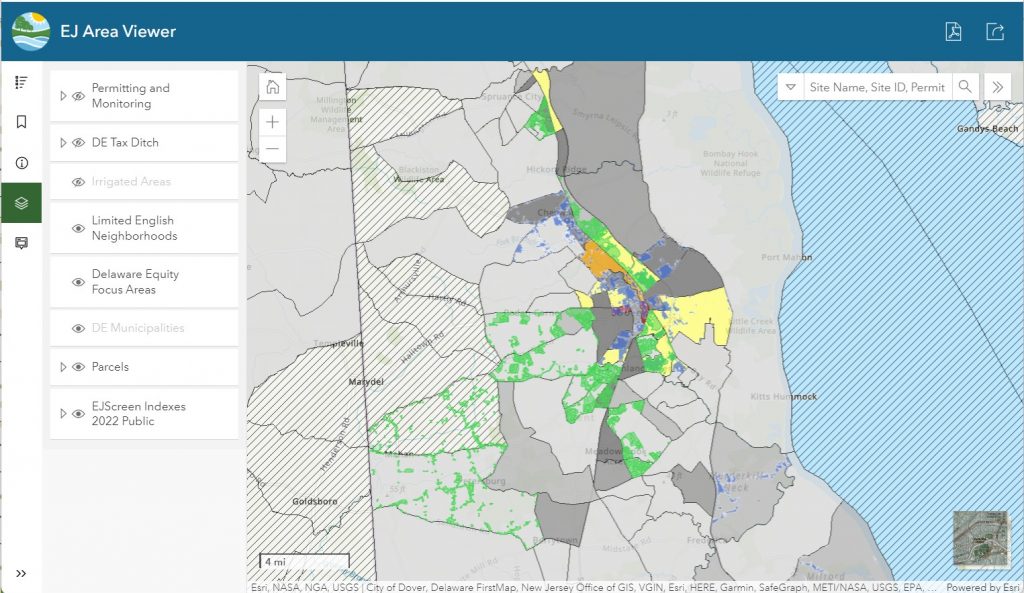The Department of Natural Resources and Environmental Control uses data tools, mapping resources and information technology to study the health and resilience of Delaware’s natural resources, manage programs and provide information to the public.
These tools include detailed datasets, digital mapping tools (known as geospatial data tools) and a variety of tools to share data and information. In addition, there are several federal and local tools to help identify traditionally underserved and underrepresented populations.
DNREC staff use an array of tools to make informed decisions about communities that may be impacted by regulatory decisions, permitting decisions or other actions. They must consider impacts to the soil, air and waters of the state, to plants, to animals and, most importantly, to the people who live in and visit Delaware.

To integrate environmental justice into its decision-making, DNREC has developed a map-based tool for agency staff that leverages data and information from DNREC programs and external partners to help staff identify communities disproportionately impacted by agency decisions and environmental issues.
The DNREC EJ Area Viewer allows DNREC staff to explore the locations that might be impacted by a program or decision and study all of these factors in a holistic, comprehensive way. Learn more about the data presented in the EJ Area Viewer.
If you have thoughts on datasets for use in future versions of the tool, or want to suggest an indicator for your community, please let us know.
The Environmental Protection Agency Environmental Justice (EJ) screening and mapping tool (EJSCREEN) uses nationally consistent data to combine environmental and demographic indicators so users can generate maps and reports. An EPA webpage walks visitors through the EJSCREEN, how to use it, understanding the results, frequently asked questions and provides other resources. If you are already familiar with the EJSCREEN, you can jump right to the screening tool.
The Climate and Economic Justice Screening Tool (CEJST), launched by the White House Council on Environmental Quality (CEQ), helps identify communities that are overburdened by pollution and historic underinvestment.
The Environmental Justice Index (EJI), released by the Agency for Toxic Substances and Disease Registry, measures the cumulative impacts of environment and vulnerability on health and well-being.
Delaware’s My Healthy Communities uses the Social Vulnerability Index (SVI) developed by the US Centers for Disease Control and Prevention to help identify traditionally under-served and under-represented populations on topics such as air and water quality, health status, healthy lifestyles and community safety.
The EPA uses the EPA Open Data and the Geospatial Platform (GeoPlatform) to share tabular and geospatial data with the public.
DNREC and other state agencies use the Delaware Open Data Portal and the FirstMap geospatial platform for tabular and spatial data sharing. DNREC’s collection of open data on the portal is a one-stop shop that includes scientific information about the state’s natural resources, information about some DNREC permitting programs, grant awards and more.
The Delaware Environmental Navigator provides access to a variety of information collected by DNREC, including permitted facilities, enforcement actions and environmental monitoring.
The Navigator provides access to many scanned documents, including permit applications and final permits. If a document is not available, you can submit a request for more information under the state Freedom of Information Act (FOIA).
To access scanned documents, use the “Search Facilities” link on the left side navigation menu. Enter the name of the facility and the DNREC program involved. To search all DNREC programs, leave that field blank.
When using the “simple search,” it’s best to use words that are specific to that facility and leave out words that might apply to many others. Search for “GeneriCorp,” for example, rather than “GeneriCorp Industries Corporation,” which will also show all facilities with “industries” or “corporation” in their name.
If you know the Facility ID used by DNREC in many permitting programs (DE-1009, for example), use the “ID Search” option. Some DNREC public notices include this number.
When the search is complete, click “view” next to the correct facility.
You can select reports to download from the Delaware Environmental Navigator database or view scanned documents by selecting “Documents” at the bottom of the left side “Details” menu.
The Toxics Release Inventory (TRI) is a publicly available dataset containing information reported annually for toxic chemicals manufactured, processed or otherwise used by certain facilities in Delaware and throughout the United States.
The Delaware Emergency Management Agency (DEMA) is the lead state agency for coordination of comprehensive emergency preparedness, training, response, recovery and mitigation services in order to save lives, protect Delaware’s economic base and reduce the impact of emergencies. DEMA is a division within the Department of Safety and Homeland Security (DSHS) and is authorized by Delaware Code, Title 20,Chapter 31§3101-3130. Sign up for DEMA’s Emergency Alert Services here. DEMA’s website also has useful resources to help prepare you and your family for disasters.
Delaware’s state web portal (delaware.gov) offers a collection of Guides to Services to help residents find services and information from all state agencies. Of particular interest: the environment, drinking water, energy tips, and complaints and reporting guides.
The Environmental Protection Agency maintains list of common Environmental Justice acronyms. DNREC maintains a searchable collection of federal and state agency acronyms on the state’s Open Data Portal.
Related Topics: community, data, environmental justice, equal access, information, mapping, resources